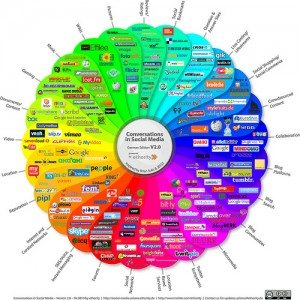 If you sometimes think you’re drowning in Twitter, Facebook, YouTube and the rest, you are not alone. I’m feeling slightly more overwhelmed than usual, myself, after listening to a webinar that was all about helping journalists get control of their social media streams. Maybe that’s because I’ve used some of the tools that were mentioned and they haven’t really done the trick. Or maybe it’s because I know the solution has more to do with time and discipline, which can be harder to find.
If you sometimes think you’re drowning in Twitter, Facebook, YouTube and the rest, you are not alone. I’m feeling slightly more overwhelmed than usual, myself, after listening to a webinar that was all about helping journalists get control of their social media streams. Maybe that’s because I’ve used some of the tools that were mentioned and they haven’t really done the trick. Or maybe it’s because I know the solution has more to do with time and discipline, which can be harder to find.
My experience may not be yours, however, so here are a few of the suggestions shared by Robin Phillips of the Reynolds Center for Business Journalism.
Set goals
Decide what you really want to accomplish on the key social media sites you participate in. Perhaps you’d like to have more followers on Twitter or Facebook. Interact more with others, Phillips advises, and use analytics to understand the impact of what you share. She’s a fan of the URL shortener bit.ly because it makes tracking activity easy. Facebook’s page insights, once reserved for power users, are now available to all page administrators. That’s great–but you still have to make time to check the analytics and then figure out what to do if the numbers are underwhelming. I would love to have more people follow NewsLab on Facebook, for example, but I haven’t yet found a way to make that happen. If you have suggestions, please let me know.
Use lists
Lists (Twitter) and groups (Facebook and LinkedIn) make it easier to keep track of just those people who are interested and involved in the specific topics you cover. Tools like Tweetdeck and Hootsuite (my personal favorite) allow you to monitor separate streams for each of your Twitter lists. But lists aren’t always as useful as they could be. You have to “curate” them–follow new people, remove a few, delete feeds from news organizations that duplicate the same information–which takes time, of course.
Filter streams
Hashtags can be a useful way of tracking tweets about a specific subject in the news. Lately, I’ve been checking #gaddafi and #libya. But if I wanted to see what’s being said in Europe, I’d probably have to check #kaddafi, as well. And then there’s #feb17 and who knows what else? WhatTheHashtag can help find related hashtags, as well as the people who have used them most who might be worth following. You can get some basic information without logging in but to make the best use of the site you need a free account. Phillips also recommends Hashtags.org (not to be confused with Hashtag.org) and I’ve seen others suggesting Twubs but I haven’t found either of them very useful. What am I missing?
Learn new tricks
Are you on LinkedIn? Did you know you can search the site for experts in specific topics? Get started at LinkedIn/skills, and make sure to add expertise to your profile so people can find you, too. Finally, it might be worth checking out the new browser, RockMelt, which promises to bring all your social media streams together in one convenient place. It’s still in beta but you can get an invitation by logging in with your Facebook account. I might just try it–when I can find the time.









1 Comment
Great post, Deborah. You really caught the essence of what I was sharing. I’m one of the organizers of #wjchat, an online (on Twitter Wednesday evenings) chat about web journalism. Last week, we focused on managing all the news and information that comes to us.
You might be interested in this archive of last week’s chat.
http://wjchat.webjournalist.org/2011/02/chat-2-23-11-managing-your-streams/
Glad you enjoyed the webinars. Shout anytime. Always happy to brainstorm about online issues and social media. There seem to be new tools and tricks every day.
Robin